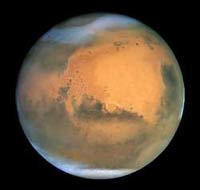Mars closest to Earth since 2003
Updated: 2007-12-19 11:28
|
|
BEIJING -- The planet Mars was closest to Earth Tuesday night at 11:45 Universal Time since 2003 and will be the closest until 2016, US astronomers said as quoted by media reports Wednesday.
People are able to see Mars by naked eyes till early February 2008, as the planet moves opposite the sun and nearest the Earth.
On average Mars moves closest to the Earth every two years and two months. These periodic encounters are due to the differences in the two planets' orbits. Earth goes around the sun twice as fast as Mars, lapping the Red Planet about every two years. Both planets have elliptical orbits, so their close encounters are not always at the same distance.
This year, Mars comes as close as 54.8 million miles (some 87 million km) -- not as close as the historic pass-by of 2003 (55.36 km), but still a night-brightener.
Although 2003 offered astronomers a view of Mars closer than this year's approach, Hubble's most recent detailed look at the red planet shows it's free of dust storms. However, ice crystal clouds in the northern and southern polar caps can be seen.
When the clouds do part, anyone can spot Mars, gleaming high above the northeastern horizon after sunset. Its reddish hue sets it apart from the bright stars of the winter constellations in that part of the sky.
Its brightness would start to fade from late January onward.
Mars looks like an orange star to the naked eye, but it's revealed as a disk with many features in modest telescopes.
Considered as the same type of planet in the Solar system as Mercury, Venus and the Earth, the surface of Mars has changed considerably due to volcanic explosions, frequent meteor strikes and dust storms within the planet's atmosphere
|
|
|
||
|
||
|
|
|
|
